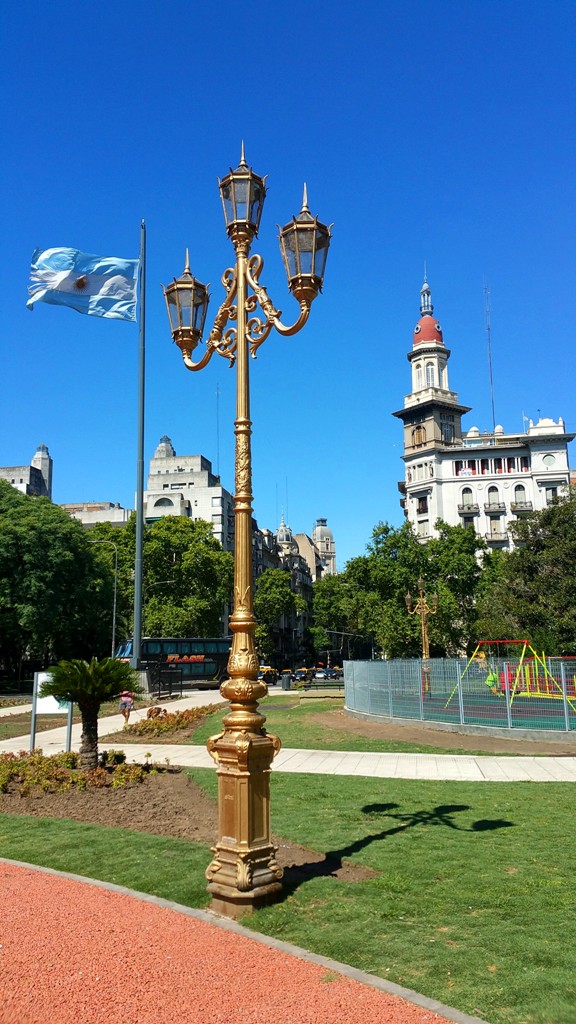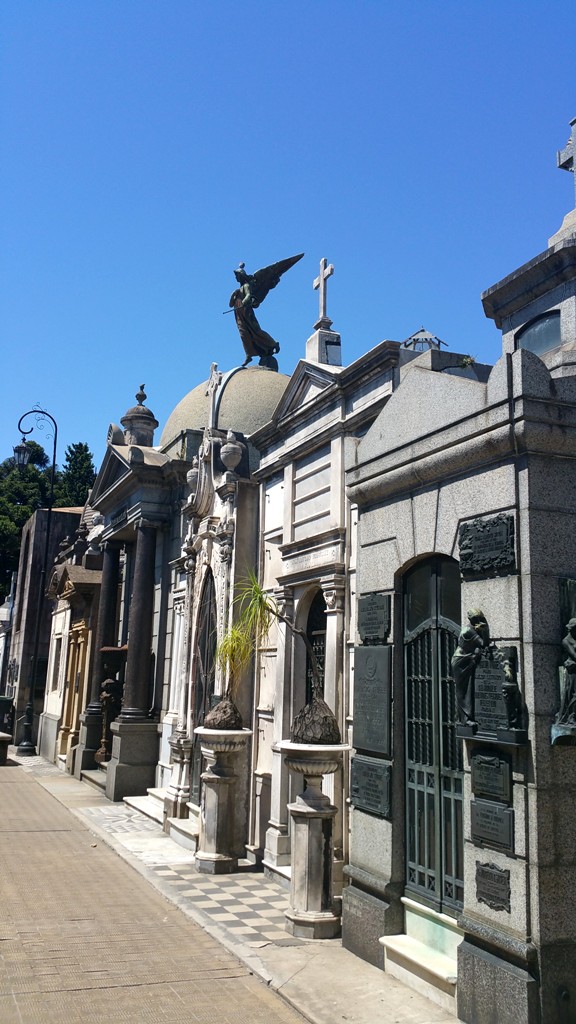Reading time: 7 min.
January 2018, Buenos Aires – Argentina
After 2 days of heat and humidity at the Iguazu Falls, landing in the posh capital of Argentina is bliss. Buenos Aires welcomes us with European architecture, geometrical streets, wide boulevards, impeccably restored buildings, warm weather. And a lot of free things to do and learn, too!
If you only have a few days in Buenos Aires and feel like walking, here’s what not to miss.

City Center
- Congress Building
- Palacio Barolo
- Evita’s Mural
- Café Tortoni & Tango
- Plaza de Mayo
- Colonial Town Hall
- Cathedral & Pope Francis
- Mothers of the May Square
- Pink Government House
We jump out of bed in our first morning in Buenos Aires, with the happiness of 2 fugitives escaping Rio de Janeiro. I don’t want to complain, but the weather, physical effort and constant scent of danger from the last week in Brazil have messed with our brains. Thankfully, a feast of cakes, fruits and croissants await in the lobby of our 4-stars hotel in the center of Buenos Aires.
As soon as we get out, we realize everything is so well organized that you can’t get lost. The streets intersect in right angles each 100 meters (“cuadras”). Metro and bus lines cross the whole city and vending machines for the unique transportation card can be easily found. We team up with other travelers in front of the National Congress Building. From here, together with Martin the guide, we enter the complicated history of Buenos Aires.





The story begins with the colonizers. Argentina was believed to be a rich land full of silver (“argent”), the equivalent of Mexico from Central America, where they had discovered gold. However, no land resources were found here. The immigration policy was favorable to the rich people in western Europe.
As we walk further to Plaza de Mayo, we find ourselves at the epicenter of Argentine politics.
Buenos Aires was known as the “Paris of South America” in the 1930s. The center of the city had many cafés, restaurants, theaters, movie houses, shops and bustling crowds. In direct contrast, these were also years of great unemployment, poverty and hunger in the capital, and many new arrivals were forced to live in tenements, boardinghouses and in outlying shanties that became known as villas “miserias”.
We pass by Café Tortoni, the French-style café opened in 1858, favorite haunt of the cultural elite with live tango. What do you know? Art takes form in the most unexpected places. The Tango came from the brothels and low cafés of Buenos Aires at the turn of the century, with influences of African, Native American and European culture. Dances from the “candombe” ceremonies of former slaves helped shape the modern day tango.
At the end of the afternoon we’re standing in the warm sun, in front of the Pink House, listening to Martin as he remembers days of the past. Argentinians have not yet forgotten the tough times of the 1980s and 1990s, when inflation reached 5000% by the year ’89, and in the 1990s it was down to 1500%. Basically, from the moment you walked into the store and picked your food until you had to pay, it already had a different price!
Casa Rosada is one of the most important and emblematic buildings in Buenos Aires. This palatial mansion is where the president and government of Argentina work, and from where Juan and Eva Perón delivered their famous speeches from the balcony.

As we walk on the streets back to the hotel, we are shocked by the similarities of Argentina’s history with the communist regime in our own country. It seems that history has an ironic way of repeating itself.
Recoleta
- Teatro Colón
- Avenida 9 de Julio
- The Big Ben of South America
- Plaza San Martín
- Malvinas/Falklands War monument
- Colonial Franciscan Convent
- Recoleta Cemetery
Day 2 is all about the classy aristocratic neighbourhoods of Buenos Aires. Energy tank refilled, off we go again!



Passing by Colon Theatre, we’re now standing in front of, as Argentinians claim, the widest avenue in the world. The street is called Avenida 9 de Julio (the 9th of July Avenue), the date of the Argentina’s Independence Day. At its widest, the avenue has twenty lanes of traffic if you include the side roads. Getting safely to the other side in one go is an Olympic competition. Eyes on the green lights, eyes on the traffic, run!











We can’t wait to see the latest hip place in Buenos Aires. Do you believe me if I told you it’s a cemetery?
The end of the day finds us wandering through impressive monuments and mausoleums. Recoleta Cemetery is not just known as one of the most beautiful cemeteries in the world but also the final resting place of Buenos Aires’ rich and famous.




Palermo
- Botanical Gardens
- Japanese Garden
Day 3 is all about nature. No maps for today, we’re heading to one of the most relaxing places in Buenos Aires, the Botanical Gardens. Walking on seven hectares of plants and trees from all over the world comes as a mental reward of all we’ve learned in the last days.




Can’t leave without checking out the Japanese Gardens nearby, inaugurated in 1967! Balance is all we’re taking with us from here.





Street tango
Dance in Argentina is practiced at the level of art. If one evening you find yourself at the intersection of Lavalle and Florida, you’ll watch a free 1 hour tango show.

Football
People found comfort in sports. Football is king in Argentina. A match is a free day at work, celebrated on the stadium or in pubs with family and friends.
Football and tango pull people out into the street, as a celebration of everyday life.

Famous people of Argentina
San Martin is the most famous person in Argentina. Trained as a general in Spain, he came to Argentina and led an army to defeat the Spanish. Then he headed north and helped Chileans and Peruvians with their independence movements, by secretly planning with Bolivar the liberation of South American provinces.
Eva Perón was the wife of Argentine President Juan Perón and First Lady of Argentina from 1946 until her death in 1952. She was born in poverty but at 15 years old she moved to the nation’s capital of Buenos Aires to pursue a career as a stage, radio, and film actress. She became an inspirational woman loved by the people, founded and ran the charitable Eva Perón Foundation and the nation’s first large-scale female political party, the Female Peronist Party.
Maradona is the most loved person in Argentina. He even has a neighbourhood and a church on his name. Scored one goal with his hand (“God’s hand”), and another memorable one (named “Goal of the Century”), helping Argentina win the Quarter-final of the World Cup 1986.
Safety in Buenos Aires
We heard about a common pickpocketing trick in Buenos Aires involving 2 thieves: one dropping a nasty-smelling substance similar to bird poop on you, and offering to lend you tissues to clean your bag. The other one would come unexpectedly from behind and steal your bag.
But if you walk with your purse in front and keep an eye on it, you’ll be fine. Best, don’t stop if somebody says you have bird poop on you! 🙂
Best time to visit Buenos Aires
December-February is summer season, with hot and humid weather. Fall (March-May) and spring (September-November) have warm temperatures and less tourists.
Where to stay
Reconquista Gardens hotel, right in the city-center
Budget
- Hotel
40-50 USD/double room/night in the city-center
- Local transportation
Universal SUBE card: 75 ARS(4 USD) +
Charge 6.5 ARS(0.3 USD)/bus ride or 7.5 ARS(0.4 USD)/metro ride
- Food
~10-15 USD/person for 1 course & drink at the restaurant
- Prepaid SIM
MOVISTAR; 40 ARS(2 USD) chip +
Charge 70 ARS(3.5 USD) credit for 10 days
Tips
- If you want to learn about the history of Argentina and have some fun while walking the city, don’t miss the Free walking tours.
- Try the Argentinian steak. It’s the best we ever had!
In January 2018 we booked one-way tickets, took our backpacks and left cozy old Europe, for (hopefully) the greatest adventure of our lives: South America. If you like our story, don’t forget to spread the word!
South America in 2.5 months – all you have to know to do it yourself
www.instagram.com/haihuistory_blog
Happy travels and stay safe!


Very help information as we are heading there next year!
LikeLiked by 1 person
Awwww have fuuuun! 😍 It’s a lovely mixture of European architecture and spanish culture! I’m here if you have any questions, we spent 3 weeks in Argentina in different regions. 😁
LikeLiked by 1 person
Thanks for the offer 🙂
LikeLiked by 1 person
“Help” should have read “helpful”!!
LikeLiked by 1 person
No problem, happy to help! 😊
LikeLiked by 1 person